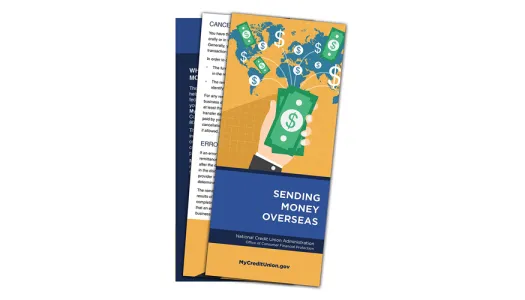Sending Money Overseas

Consumers in the United States send billions of dollars to friends, family and businesses in other countries through remittance transfers, also known as international money transfers or international wire transfers.
Generally, there are fees and other costs associated with this service.
In this brochure, we will review how certain federal consumer financial protections make it easier for you to understand the true cost of a remittance transfer and how to get answers if something goes wrong.
Examples of Remittance Transfers
A remittance transfer is an electronic transfer of funds by a consumer. Examples of remittance transfers include:
- Transfers of cash or another type of payment to a company or financial institution to be sent to a foreign country
- Adding funds to certain prepaid cards through a prepaid card program
- International Automated Clearing House (ACH) transactions
- Online bill payments and other electronic transfers scheduled in advance
Understanding Your Rights
In certain circumstances, remittance transfer providers must give you specific disclosures before the transaction is made, provide proof of payment and offer a way for you to dispute or cancel the transfer.
These consumer protections apply to most remittance transfers if:
- They are more than $15
- They are made by a consumer in the United States
- They are sent to a person or company in a foreign country
- They are made from a consumer account set-up primarily for personal, family or household purposes
Remittance transfer providers may be either a financial institution or a company. The financial institution or company must apply these federal consumer financial protections if it provided more than 100 remittance transfers in the previous year or in the current year.
The following sections provide an overview of these federal consumer financial protections.
Pre-Payment Disclosure
Each time you authorize a transfer of funds, the financial institution or company is required to give you a prepayment disclosure before the transfer is sent.
The pre-payment disclosure must contain:
- The amount of the money to be transferred
- The exchange rate
- The amount of any fees and taxes
- The amount to be received by the designated recipient
- If applicable, a statement that additional fees and foreign taxes may apply
This disclosure information is to be provided free of charge. You are under no obligation to continue with the transfer after receiving the pre-payment disclosure.
Also, you can use this information to decide to approve the transfer or comparison shop to find the lowest-cost provider.
Proof of Payment Disclosure
Once you pay for a transfer, you will receive a receipt or proof of payment disclosure that includes the same information on the pre-payment disclosure, along with:
- Date of availability
- Name of the recipient
- Error resolution and cancellation rights
- Transfer provider contact information
- Transfer date
- Contact information for the relevant state regulator and the Consumer Financial Protection Bureau for questions or complaints
Cancellation Rights
You have the right to cancel a remittance transfer, either orally or in writing, within a specified period of time. Generally, you have up to 30 minutes after you pay for the transaction to cancel and get a refund.
In order to cancel the transaction:
- The funds must not have been picked up or deposited in the recipient’s account
- The remittance service provider must be able to identify the sender and the transaction information
For any remittance transfer scheduled three or more business days in advance, you must cancel the transfer at least three business days before the scheduled transfer date. The provider must refund the total amount paid by you within three business days of receiving the cancellation request. Your refund will include all fees and, if allowed, taxes.
Error Resolution
If an error occurs, you must report the error so that the remittance transfer provider receives it within 180 days after the date the transfer was to be available, as stated in the disclosure. At that time, the remittance transfer provider will have 90 days to investigate and make a determination.
The remittance transfer provider must report to you the results of the investigation within three business days after completing its investigation. If the provider determines that an error did occur, it must correct the error within one business day or as soon as possible.
Where Can I Find More Information?
The NCUA has more information to help consumers better understand their federal consumer financial protections. If you have questions visit MyCreditUnion.gov, or call the NCUA’s Consumer Assistance Center at: 800-755-1030.
The online Consumer Assistance Center includes frequently asked questions on issues such as deposit accounts, consumer loans, mortgages and fraud prevention.
MyCreditUnion.gov is also a useful resource for learning about personal finance and protecting your money.